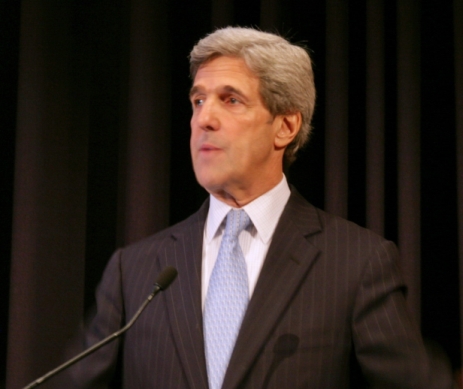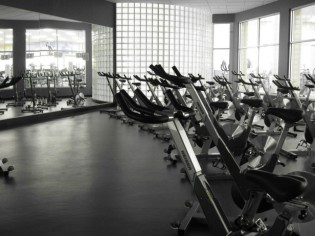From activists to politicians, everybody loves to talk about the promise of green jobs. But in reality, who the heck actually has a green job, and how do you get one? In our new column, “I Have a Green Job,” Grist will be regularly profiling one of the lucky employed who has landed a job in the new green economy, or a green job in the old economy.
Know someone with a green job and a good story? Tell us about them!
 Could bikes like these help burn calories without wasting watts too?Photo: janeyeseeyou via FlickrTo plenty of people in a recessed America, “business as usual” would sound pretty appealing. But for Robert Kravitz, a property owner and lifelong fitness enthusiast, that wasn’t enough. When his building tenants went bankrupt, he twisted bad luck into the opportunity to plant a stake of sustainability in Orange, Conn., by opening the “people-powered” gym, Go Green Fitness. Now Kravitz is motivating Nor’easters to spin their way to healthier, happier lifestyles as well as a healthier environment on 25 exercise bikes plugged into the electric grid.
Could bikes like these help burn calories without wasting watts too?Photo: janeyeseeyou via FlickrTo plenty of people in a recessed America, “business as usual” would sound pretty appealing. But for Robert Kravitz, a property owner and lifelong fitness enthusiast, that wasn’t enough. When his building tenants went bankrupt, he twisted bad luck into the opportunity to plant a stake of sustainability in Orange, Conn., by opening the “people-powered” gym, Go Green Fitness. Now Kravitz is motivating Nor’easters to spin their way to healthier, happier lifestyles as well as a healthier environment on 25 exercise bikes plugged into the electric grid.
Q. What sets Go Green Fitness apart from other workout centers?
A. I, along with two other families, built the first commercial green building in the state of Connecticut [where Go Green Fitness is located]. I didn’t want to do Go Green Fitness and just wave a green banner because it felt good. I followed Passive House building techniques, which are very intriguing to me. The indoor air quality is just outstanding. And it was very important that the whole facility be anti-bacterial, fungal, mold, and mildew, and zero-VOC (Volatile Organic Compounds) from ceiling tiles to paint and the flooring.
The other thing that is really intriguing to people is the fact that we’ve got 25 spin bikes — so, indoor cycling — and each bike we’ve got connected to an individual generator. We’re actually creating clean, sustainable energy without burning fossil fuels.
Q. Does this energy actually power your facility?
A. It doesn’t directly power anything that’s connected to our inverter box. But it does feed into our electric meter. Our goal is very simple. We want to produce more energy than we use, and we do use energy. I think that’s a step in the right direction.
Q. Has the electricity produced from the spinning classes reached a level where money is actually coming back to you from the utility?
A. I’m going to realize that sometime [this month]. We’re not going to get a million dollars back. It’s not that kind of effort; it’s just a start. But we should be getting between $75 and $180 back [every three months], which is not bad.
Q. So it’s not really a big number right now …
A. In all honesty, it’s just smart, it makes sense. I’m not the first person to think of this idea. Around 2002 or 2004, an electrical engineer wired four treadmills so that people could come in and dock their iPod or cell phone, and while they were exercising, they were charging it. And I think that’s great! I read this at 10 o’clock at night — just on the Internet — and I was ready to go! Think about how many treadmills or ellipticals or stationary bikes there are in the country. It could all add up.
Q. About how much energy does an average spin class produce?
A. They are anywhere between 200 watts in an hour to typically 800 watts per hour, depending on who’s there. The typical person will do 25-45 watts in an hour. There’s a monitor that we have similar to one on a treadmill that would monitor calories per hour. This monitors watts per hour. It’s a personal gauge to tell your efforts from class to class, or to see if you’ve worked hard. We do have 20 people who can do more than 100 watts in an hour.
Q. You launched Go Green Fitness this past December. The middle of a recession is a very interesting time to be opening a business, wouldn’t you say?
A. I would say. I felt at the time that I needed to do something that was very positive. I’m a building and commercial-property owner, and the economy did hit me full force. It became obvious to me that in order to bring one particular building back to life, where Go Green Fitness is located, I needed to do it myself.
Q. If someone wanted to replicate this kind of project, what advice would you give to them?
A. You have to be passionate. People know when you care, and that’s why we’re successful, I’m thoroughly convinced. Also, this was a learning experience for me. It didn’t just happen, there wasn’t a blueprint. You just have to be in tune with the choices that can be made.
Q. What’s your business model and how is that different than other gyms?
A. We don’t do a membership, because we don’t just want someone to buy a membership for a year and for whatever reason, not come. I didn’t want people to drive by, see the Go Green Fitness sign, and feel like they lost money. That’s been the business model. Create an inviting environment, where it’s real and people come in and know that we care, and we want them to succeed.
Q. Absolutely. Has opening this business changed your life, and if so how?
A. The best thing that has happened to me is that I have met so many people I would not have met. And they’re all positive. The people have been the best part.
Q. So would you say it’s been the people who make you the most hopeful for creating a more sustainable future?
A. I would agree with that. You know who really gets it? Kids get it. I’ve had 10 or 15 schools do field trips to Go Green Fitness, and they’ve asked great questions.
I could be more bottom-line driven, but I’m not going to do it. I just want people to succeed, that’s the main goal.



